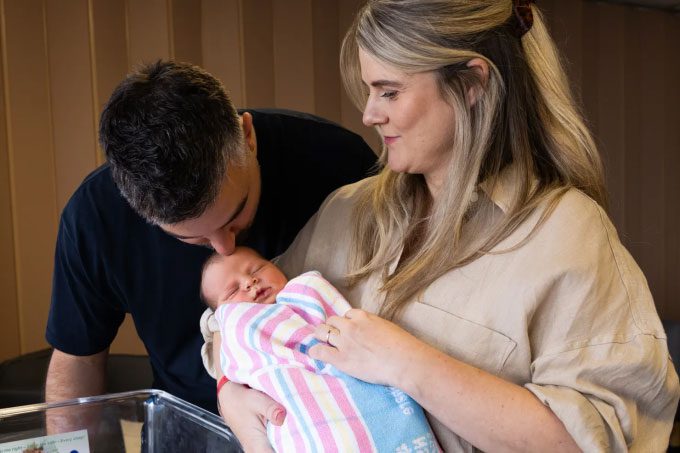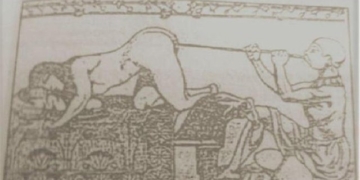Bonnie, the first Australian baby born through IVM technology transferred by Vietnamese doctors, brings hope to thousands of infertile women in the country.
Weighing 4.1 kg, Bonnie was born at the Royal Women’s Hospital last week and has been described as a “miraculous miracle,” according to The Sydney Morning Herald – Australia’s leading and oldest newspaper.
Leanna, Bonnie’s mother, has become the first Australian woman to give birth through CAPA-IVM (in vitro maturation of immature oocytes). This method is considered a “breakthrough alternative” to IVF (in vitro fertilization). Previously, Leanna had failed with IVF.
“The most wonderful thing is that Bonnie is here and brings hope to many people,” the mother said.

Baby Bonnie with her parents. (Photo: The Sydney Morning Herald).
The IVF technique requires women to inject hormones to stimulate the maturation of follicles before they are retrieved from the ovaries for fertilization. In contrast, IVM involves extracting tiny immature oocytes from the follicles, maturing them in vitro, and then fertilizing them with sperm to form embryos as usual.
With this new technique, patients do not have to use ovarian stimulation drugs or only use very few, requiring only two days to harvest eggs instead of the 2-4 weeks needed for IVF. This reduction in medication costs significantly lowers treatment expenses.
Professor Rob Gilchrist from the University of New South Wales, one of the designers of the first CAPA-IVM program in Australia, stated that the first baby born is the result of collaboration between scientists at My Duc Hospital (Ho Chi Minh City) and Belgium.
“IVF has helped bring millions of children into the world, but many women are unable to undergo this technique,” Professor Gilchrist said. Women with polycystic ovary syndrome, when injected with drugs for IVF, may experience overstimulation of the ovaries, leading to discomfort, bloating, difficulty breathing, and even life-threatening conditions. Additionally, those with certain types of cancer may find that ovarian stimulation drugs increase estrogen levels—hormones produced by developing follicles—that can accelerate cancer progression. Consequently, many patients after cancer treatment dare not consider having children.
IVM opens up the possibility of motherhood for thousands of Australian women suffering from polycystic ovary syndrome and those battling cancer. Professor Bill Ledger, Head of the Reproductive Medicine Department at the Royal Women’s Hospital, stated that the hospital is ready to transfer IVM technology to colleagues in the country with the hope of more babies being born.
Regarding the successful transfer of IVM technology to Australian colleagues, Dr. Ho Manh Tuong from My Duc Hospital proudly remarked: “In the past, Vietnamese doctors went to Australia to learn new techniques to treat Vietnamese patients; now we are happy and proud that the opposite has happened.”
According to Dr. Tuong, the technology transfer project began in 2018, with Australian doctors coming to My Duc Hospital to learn the IVM technique. The implementation process faced interruptions due to the COVID-19 pandemic. In 2022, after the pandemic, Australia sent four personnel to Vietnam to learn IVM based on the latest protocols and successfully returned home to help some women conceive.
Vietnam has been applying IVM in infertility treatment since 2007. Ten years later, Vietnam became the country with the most IVM procedures globally, transferring its technology to several countries such as Australia, the USA, France, Belgium, Spain, and Singapore…

Experts from the University of New South Wales learning IVM techniques at My Duc Hospital in 2022. (Photo: Hospital provided).
|
IVM is currently indicated for patients with polycystic ovary syndrome, those with a high number of follicles in the ovaries, individuals needing egg preservation to maintain fertility for cancer treatment, patients resistant to ovarian stimulation drugs, and younger patients with many follicles… The drawbacks of this technique include its complexity and the limited number of embryos produced. If embryo transfers fail multiple times and all frozen embryos are used, the process must start again with egg retrieval. |



















































